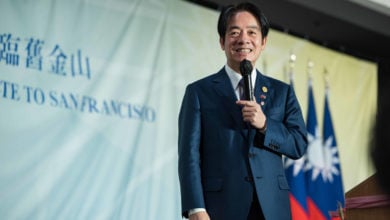Photo: Pivot to Peace and ANSWER Coalition members on Feb. 27. Liberation photo
To oppose recent hostile measures taken by the U.S. government that could lead to a devastating conflict between the United States and China, organizers from Pivot to Peace and the ANSWER — Act Now to Stop War and End Racism — Coalition gathered in front of the White House on Feb. 27 to commemorate the 50th anniversary of the Shanghai Communique’s signing. Signs reading “No cold war with China!” and “U.S. hands off Taiwan” sent a clear message: The U.S. government must respect the Shanghai Communique.
On Feb. 27, 1972, a diplomatic document known as the Shanghai Communique was issued on the last evening of U.S. President Richard Nixon’s visit to China. The document, negotiated by U.S. National Security Advisor Henry Kissinger and Chinese Premier Zhou Enlai, was the foundation for the normalization of relations between the two countries.
In a speech given at the rally, Pivot to Peace organizer Ken Hammond noted that in November 2020 President Biden told Chinese President Xi Jinping that the United States would continue to adhere to the Communique. However, as Hammond noted, “The actions of the American government have moved in the exact opposite direction.” Hammond called on the U.S. government to renew its commitment to policies of mutual benefit and respect.
The Communique constituted the first diplomatic agreement signed by the People’s Republic of China and the United States. Its core message was one that promoted mutual benefit and peace, stating that “the two sides agreed that countries, regardless of their social systems, should conduct their relations on the principles of respect for the sovereignty and territorial integrity of all states, non-aggression against other states, non-interference in the internal affairs of other states, equality and mutual benefit, and peaceful coexistence.”
The document also described how the United States would address Taiwan, with the United States acknowledging “that all Chinese on either side of the Taiwan Strait maintain there is but one China and that Taiwan is a part of China. The United States Government does not challenge that position. It reaffirms its interest in a peaceful settlement of the Taiwan question by the Chinese themselves.” The United States also agreed to progressively withdraw all military forces from Taiwan.
These improving relations between China and the United States developed during a period in which the United States believed it could dominate the Chinese economy. In the decades that followed the Shanghai Communique, U.S. corporations took advantage of China’s market reforms that opened the country up to the global capitalist economy. Access to lower production costs and cheaper Chinese labor were opportunities for U.S. capitalists to improve their bottom line.
In recent years, the Chinese economy has approached the size of the U.S. economy. Under the leadership of the Communist Party of China, 800 million people have been pulled out of extreme poverty. As a response to China’s growing economic strength, the U.S. government dramatically shifted their posturing towards the country beginning with President Obama’s “Pivot to Asia.” Initiated in 2012, the United States shifted its military and economic strategy to combatting China’s growing presence on the world stage. Forty years after the Communique’s signing, the United States government has completely abandoned its prior commitments, positioning 60% of its naval forces in the Pacific as a clear sign of aggression.
In 2021, it was revealed that the United States maintains a troop presence in Taiwan, something that was condemned by the Chinese government as a hostile move. The sale of missile systems, military technology, and other weapons to Taiwan continues to increase as well.
The ANSWER Coalition’s National Director Brian Becker denounced these militaristic policies, asserting that “reckless and bad decision making can provoke a confrontation that would not only be between two countries but could become regional, even becoming global.” He noted that “reckless provocative actions in the South China Sea designed to contain China” would naturally lead to “China taking countermeasures.” This should concern the American public, given that “when both sides climb the escalation ladder, it’s very hard to get off it.” He affirmed that cooperation, not antagonistic relations, would benefit both the people of the United States and the people of China.
The U.S. military buildup has not been the only point of growing hostility. The U.S. government and its loyal servants in the corporate media has been waging an intense demonization campaign to propagandize the U.S. public into fearing China. Just this year, Congress proposed allocating $500 million to produce negative news coverage of China. As ANSWER organizer Sean Blackmon noted at the event, these often racist and sensationalized portrayals of the Chinese government and society in corporate news have contributed to a dramatic increase in anti-Asian hate crimes.
A recent study by the Center for the Study of Hate and Extremism found that anti-Asian hate crimes rose by 339 percent from 2020 to 2021. Chinese students and professors have also been targeted by universities and the U.S. government. In 2021, the FBI admitted to falsely accusing a professor at the University of Tennessee of being a Chinese spy. The FBI has faced no repercussions.
In regard to the growing anti-Asian sentiment in the United States, Blackmon noted how it “is a direct result of the United States policy towards China, which is just a continuation of the historic racist anti-Chinese and anti-Asian policies of the United States … Treating China like it’s an invading horde.”
ANSWER organizer Emi Lockwood closed the event by clearly affirming that the United States government has failed to respect not only China’s sovereignty, but the sovereignty of various states around the world. Lockwood asked, “What does peace mean to the country that has 800 military bases around the world?” referring to the global U.S. military machine that protesters denounced.






